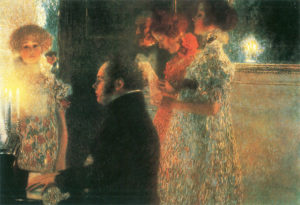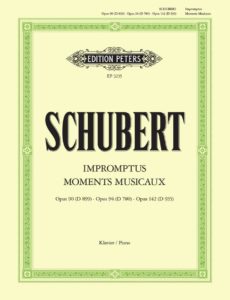Published in 1828, the year Schubert died, and written between 1823 and 1828, the six Moments Musicaux (literally “musical moments”) are amongst Schubert’s best-loved works for piano and are as accessible to the competent amateur pianist as they are to the concert artist. They are akin to Beethoven’s Bagatelles in their brevity and quixotic characters. I first encountered these delightful pieces in my early teens when my mother bought me an Edition Peters copy of the two sets of Impromptus with the Moments Musicaux sandwiched between them; they, and the Impromptus, have remained favourites of mine ever since.
These fleeting pieces, all lasting less than 10 minutes and one just over a minute, were written to satisfy the Viennese public’s growing appetite for Albumblätter – literally “album leaves” – short pieces which could be played and enjoyed at home. It is quite likely that Schubert played them himself at informal musical gatherings with his friends. They may be brief but they are rich in character and display Schubert’s many moods, the paradox of Schubert’s life and indeed of all human existence and the wonder of being alive – from happiness and hope to profound introspection and poignancy, intimacy and tenderness, terror, rage and desolation.

Schubert at the Piano – Gustav Klimt (1899)
What I find so wonderful about the Moments Musicaux is that they encapsulate Schubert’s compositional style and musical personality in microcosm. The name “Moments Musicaux” suggests something improvisatory or unpremeditated, but like the piano sonatas and Impromptus these are carefully structured works (usually in ABA/Ternary form). Yet Schubert’s daring use of harmony, and unexpected or enigmatic modulations, combined with a subtly shifting dynamic palette, disrupt the usual established continuity of form, creating music which is intense, dramatic and emotionally profound. The Moments Musicaux are supreme examples of Schubert’s ability to suggest the subtlest nuances of emotion which shift and alter, literally in a moment. Even in their bigger, louder gestures, these pieces are intimate, almost confidential in tone, private and mysterious, their kaleidoscopic, fleeting yet profound emotions revealed in the apparent simplicity of the music.
The first Moment, in C major, opens with a sweetly bucolic but also rather haunting fanfare, and within three bars the mood has shifted with the introduction of C minor chords. It is these harmonic shifts which give the music a tender wistfulness, while the recurring triplets infuse a sense of playfulness, even in the minor key. The switch between tonalities creates emotional drama and often Schubert is at his most poignant when writing in the major key.

Edition Peters Score of Impromptus and Moments Musicaux
The second in seemingly serene A flat major is structured ABABA, with the A section varied each time it returns. Despite its Sicilienne rhythm, the A section is suffused with tragedy, reinforced by the circular form and repeating themes. Again, unexpected harmonies and astonishing modulations give the music a dramatic intensity, and the f-sharp minor sections are painfully sad, especially the second one, the plaintive melody now magnified with accented chords. The return of the A-flat major section is a momentary consolation before the shadow of sadness descends again, though without any sense of regret.
The third (F minor) by contrast is a naive dance, originally published as an Air Russe, and in ABA (ternary) form with a coda. Its sprightly character, highlighted by accents, staccato and grace notes, is akin to the ballet music for Rosamunde and the Marche Militaire. The constant oscillation between minor and major confirms the folksy, playful nature of this music.
The fourth (C-sharp minor) is the longest of the set, again scored in ternary form with a coda. The A sections are a perpetuum mobile, with a flavour of a Baroque dance in the RH semi-quavers and stomping bass quavers. Although marked Moderato, its mood is restless. A single bar’s rest signals the B section. Dreamy, lilting and intimate, the sense of release is palpable in this rather Bohemian trio. The opening material returns at bar 114 but there is a 2-bar recollection of the middle section in the coda, like a fleeting memory.
The fifth (F minor) is the most energetic of the set. Like the previous piece, it is also in ABA form and is marked by an emphatic rhythmic motif of one long note (crotchet) and two short ones (two quavers), reinforced by accents on the first beat of the bar and abrupt dynamic shifts. There is no room for a consoling middle section in this galloping music.
The final moment (A flat major) is one of the pieces I learnt as a child without appreciating its emotional depth. Coming back to it in my 50s, and having spent several years immersed in one of Schubert’s late piano sonatas, this music encapsulates Schubert’s extraordinary soundworld in miniature form. Like the first moment it is a minuet and trio (in D flat), and once again daring, ambiguous harmonies, unexpected modulations and graduated dynamics, together with the use of rests, create a dramatic intensity. Here tiny gestures speak eloquently, and a single line is freighted with emotion. The closing cadence is utterly desolate, its bleakness reinforced by the unharmonized A flat in double octaves.


